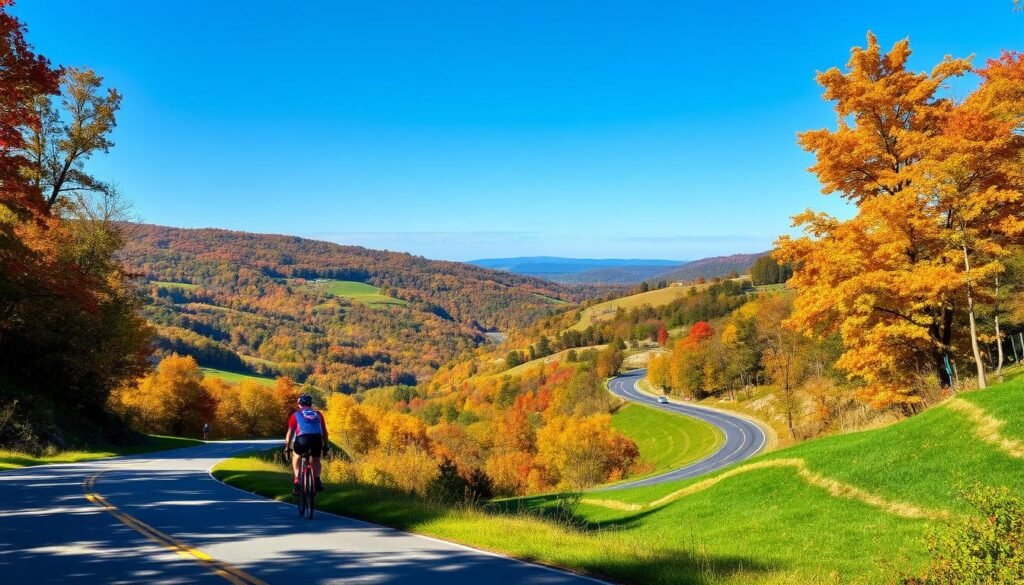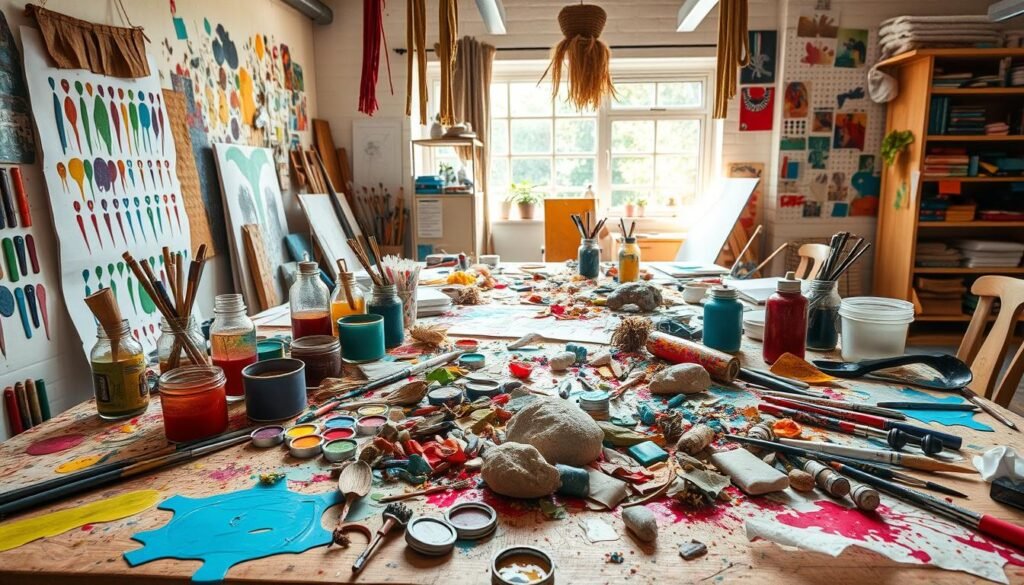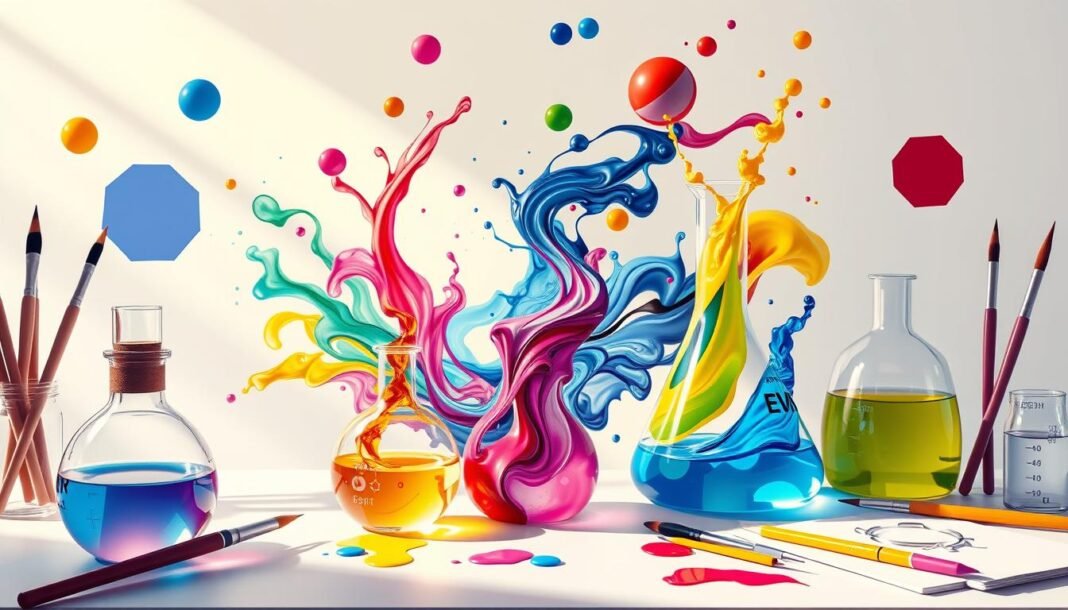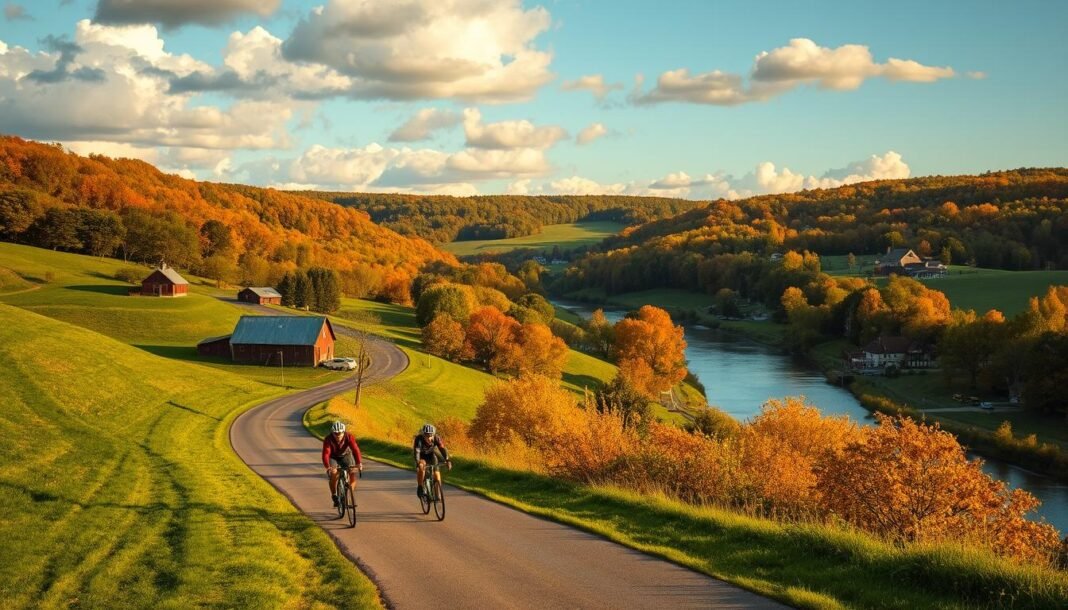Design chemistry is a fascinating concept today. It bridges artistic expression and scientific inquiry. It inspires people to unlock creativity by combining design science with projects that provoke thoughts and ignite passion.
By diving into creative projects, anyone can use their imagination to understand complex scientific ideas better. Exciting opportunities at local libraries include educational programs and interactive events. These can lead to unique artistic projects that tackle modern scientific challenges. Let’s explore the dynamic link between creativity and science together.
Key Takeaways
- The synergy between design and scientific principles enhances creative expression.
- Engaging in artistic projects fosters a deeper understanding of science.
- Local libraries offer valuable resources to participate in creative exploration.
- Unlock creativity through hands-on, interactive design projects.
- Approaching scientific challenges with artistic ideas can lead to innovative solutions.
The Intersection of Design and Science
When we look at how design and science come together, it’s really interesting. It shows us new ways to see the world. Creativity in science mixes with art, leading to new discoveries. This mix makes learning fun and brings new ideas.
Uniting Creativity with Scientific Principles
Art and science projects make learning easier. They connect creativity with real study. Making models or infographics helps us understand complex topics better. It shows that beauty can help us learn.
Some cool projects include:
- Creating interactive displays that illustrate chemical reactions.
- Designing educational videos that combine animations with scientific explanations.
- Developing sculptures that represent biological structures.
- Using photography to document ecological changes and their impact on local habitats.
These projects blend art and science in amazing ways. They help everyone, from students to experts, use their creativity with science. This helps us all value nature’s laws more deeply.
| Project Type | Description | Educational Outcome |
|---|---|---|
| Model Building | Constructing 3D models to represent scientific systems. | Enhanced spatial understanding of complex structures. |
| Infographics | Visual representation of data to simplify information. | Improved data literacy and comprehension. |
| Interactive Displays | Hands-on exhibits that invite audience participation. | Promotion of practical learning and curiosity. |
| Art Installations | Creating artworks that address environmental issues. | Increased awareness of ecological challenges. |
This shows how design and science work together. It leads to new thinkers who love both art and science.
How Design Projects Foster Scientific Understanding
Design projects for science help various people understand scientific ideas better. By using hands-on learning, like building models or experimenting, these projects simplify complex ideas. For instance, when learners make ecosystem or chemical reaction models, they connect what they know to real-world practices. This deepens their understanding.
Exploring Science Through Hands-On Activities
Design plays a key role in learning, especially in schools. Students get involved by:
- Building structural models in physics classes
- Conducting chemical experiments with creative presentations
- Simulating biological processes through interactive displays
Such activities spark interest and help students remember difficult concepts. Taking part in hands-on learning projects allows them to test theories and see results. This kind of learning also boosts their curiosity.
An excellent example of design projects making science understandable involves the Hudson River. Projects about its environmental impact show the close link between art, science, and being proactive. They demonstrate how using design to teach can lead to better care of our planet and get the public interested.
| Project Type | Scientific Focus | Learning Outcome |
|---|---|---|
| Model-Building | Physics | Understanding forces and structures |
| Chemical Reactions | Chemistry | Visualizing molecular interactions |
| Ecological Simulations | Biology | Comprehending ecosystem dynamics |
Each science project showcases the power of teamwork and collaboration. They prove that working together boosts creativity and scientific exploration. These shared efforts lead to a stronger grasp of science and encourage learning for life.
Discover Hudson Valley Ride: An Artistic Cycling Adventure
The Hudson Valley Ride is a great way to see the area’s beauty. It offers a bike tour that lets you explore Hudson Valley by bicycle. On this tour, amazing views surprise you at every turn.

Riders enjoy unique paths that go through parks, historical spots, and pretty towns. The different views—from hills to calm rivers—make the trip memorable. Every path is full of adventure chances, letting riders enjoy nature’s beauty.
During the ride, the trail’s variety encourages everyone to see nature as an artist. It makes the trip a mix of excitement and beauty. This adventure lets cyclists connect deeply with nature’s wonders.
- Scenic cycling in Hudson Valley is good for your mind and body.
- Art placed along the way sparks your imagination.
- Beautiful views offer great spots for photos, blending nature and art beautifully.
This ride makes you love local art and keeps you active. Cyclists, alone or with buddies, feel a stronger bond with the Hudson Valley’s lively views.
| Feature | Description |
|---|---|
| Trail Length | Varies from 10 to 50 miles |
| Scenic Overlooks | Many spots to stop and enjoy the scenery |
| Local Art | Art installations are part of the journey |
| Health Benefits | Boosts fitness and mental wellbeing |
By choosing to discover Hudson Valley Ride, bikers start a journey that honors nature’s beauty and creativity. This biking adventure is perfect for those who love cycling and art.
Unlocking Creativity Through Exploration
Exploration is key to unlocking creativity. New environments, cultures, and experiences open doors to innovative thoughts. Each journey brings fresh perspectives, fueling the creative process. This lets individuals explore their artistic sides more deeply.
The Importance of New Experiences
Leaving your comfort zone can lead to breakthrough ideas. For instance, the Hudson Valley Ride shows how exploration sparks great ideas. Being in different situations brings new insights, boosting creativity.
Here are tips to foster exploration:
- Seek out new hobbies: Trying new things can spark passion and innovation.
- Engage with diverse communities: Meeting different cultures offers new viewpoints.
- Embrace spontaneity: Unexpected plans can lead to creative discoveries.
These strategies promote personal growth and boost creativity. Seeing the world through various lenses enriches the mind. It opens the path to incredible artistic discovery.
| Activity | Benefit | Creative Outcome |
|---|---|---|
| New Hobbies | Expands skills and knowledge | Unique artistic ideas |
| Cultural Engagement | Broadened worldview | Innovative perspectives |
| Spontaneous Adventures | Breaks routine | Fresh inspirations |
Discovery leads to a deeper understanding of creativity. Embracing exploration changes how we create. It fosters deeper connections with ourselves and the world.
Hands-On Decorating Projects for Scientific Discovery
Hands-on decorating projects offer a unique way to uncover science through design. These DIY activities turn everyday items into lessons. Building terrariums, making mobile solar systems, and doing easy chemistry experiments are just the start. They ignite curiosity and help learn big scientific ideas.
- Terrarium Construction: Put together a small world. It shows how plants grow and how environments work.
- Mobile Solar System: Create a model to understand how planets move and their sizes and distances.
- Chemistry Experiments: Use things from around the house to learn about chemical reactions and different forms of matter.
These projects are more than just for show. They are hands-on learning experiences. They let you dive into science topics in a fun way. Mixing art and science helps you learn more deeply while you’re having a great time.
Utilizing AI in the Creative Process
In recent years, technology has greatly changed creativity. AI is now a big part of the arts and design. It offers tools that help artists make new things. This is all thanks to Generative AI, which is leading the way.
Generative AI and Creative Potential
Generative AI is a game-changer for artists. It looks at huge amounts of data to find patterns. These patterns can inspire new art. With AI, creators are breaking new ground. They use AI for artistic inspiration in ways never thought possible before.
Artists use AI to suggest new ideas for their projects. This includes different shapes, materials, and ways of making things. It’s about exploring new options that were once hard to imagine.
AI is changing creativity in many ways, such as:
- Helping architects make new kinds of buildings with generative design software.
- Algorithms that make unique art or designs from specific ideas.
- Disovering, new materials for artists to use in their work.
Utilizing AI in creativity shows how AI can make work easier. It pairs technology with human creativity. This mix makes more interesting and new art. Here’s how traditional methods compare to those improved by AI:
| Aspect | Traditional Methods | AI-Enhanced Practices |
|---|---|---|
| Idea Generation | Manual brainstorming | Data-driven insights |
| Design Process | Trial and error | Algorithmic suggestions |
| Material Discovery | Limited options | Vast possibilities |
More and more artists are using these tools, changing how we create. This blend of technology and art brings new possibilities. It’s a thrilling time for creativity, thanks to Generative AI. Learn more in the full discussion.
Building Creative Confidence in Your Work
Creative confidence is key to improving your art. It brings joy but also challenges. Fear of judgment, striving for perfection, and comparing yourself to others are common issues. It’s important to face these obstacles to grow your confidence and joy in your work.
Overcoming Creative Barriers
There are ways to overcome these challenges and boost creativity. Here are some strategies to help:
- Practice self-compassion: Understand that mistakes help you learn. Let yourself try new things without aiming for perfection.
- Collaborate with others: Talking with other artists can spark new ideas and support, encouraging creativity.
- Set achievable goals: Break big projects into smaller steps. This helps keep you focused and builds your artistic skills bit by bit.
- Embrace risk-taking: Try new mediums or techniques to step out of your comfort zone. This freedom can lead to amazing discoveries.
Building confidence in your art begins with a growth mindset. Reflect on your progress and celebrate your wins, no matter how small. This makes the creative journey more rewarding.
The Role of Inspiration in Artistic Endeavors
Inspiration is the spark that ignites creativity. It helps artists to try new things and expand their creative horizons. Inspiration shapes the journey of an artist by encouraging the exploration of various creative sources.
There are many ways to find artistic inspiration. The world is full of influences that can stir the imagination. Nature, cultural events, cities, and books offer new viewpoints. Using technology in art opens doors to new explorations, pushing past old limits.
Seeking Inspiration from Various Sources
Interacting with the world around us can boost creativity and open-mindedness. By paying close attention, we can find art in daily life. Keeping a journal for creative thoughts and drawings helps to keep track of those fleeting ideas. It becomes a source for future work.
- Nature walks inspire with colors, textures, and sounds.
- Art galleries and museums evoke historical narratives and cultural contexts.
- Books and poetry introduce diverse voices and innovative ideas.
- Social interactions and collaborations lead to the fusion of different methodologies.
Experiencing art first-hand also deepens our understanding. Participating in workshops and community events allows us to meet other artists. We share ideas and find common ground in our creative practices. Such connections fuel our creative processes with new inspiration.
Experimenting with New Materials and Techniques
Artists grow by trying new things. Working with different materials can lead to exciting discoveries. Each one, from paint to resin or found items, has special traits. This exploration sharpens skills and brings new ideas.
Playing with various tools and techniques opens up many creative paths. It allows artists to see their work in new ways. The key is to keep an open mind and enjoy the journey of creation.
Embracing Creativity Through Experimentation
Entering the realm of new artistic methods means getting out of your comfort zone. Trying things like mixed media or digital art brings surprising results. It’s challenging but essential for growth and new ideas.
- Experiment with diverse art supplies, including unconventional items.
- Learn various techniques, such as printmaking or collage.
- Integrate different styles, mixing realism with abstract forms.
Making mistakes is a big part of trying new things. Artists should see errors as chances to learn. Every slip-up teaches us about how different materials and methods can work together. This process benefits not just the artist but the whole art world.

| Material | Possible Techniques | Example Project |
|---|---|---|
| Watercolor Paint | Wash, Wet-on-Wet | Landscape Painting |
| Resin | Pouring, Layering | Jewelry Design |
| Found Objects | Assemblage, Collage | Mixed Media Sculpture |
By embracing this adventurous spirit, artists can explore new horizons. This journey of discovery can change not just individual pieces, but the essence of creativity itself.
Conclusion
The journey through design and science shows a deep connection. This connection improves our understanding of creativity.Hudson Valley Ride is an example. It shows how art and science meet.
This mix of art and science helps us think in new ways. It lets us see beyond usual limits. It encourages us to use our creativity fully.
We invite you to try experiences like Hudson Valley Ride. They show the mix of art and discovery. Such adventures push you to new places. They fire up your creative side.
By taking part, you grow and inspire others. You show them the beauty in art and science together. Your actions help others see creativity in new ways.
Keep exploring on your creative journey. Every step can lead to new ideas. This thought on creativity shows that all projects can bring innovation.
Always push boundaries and explore. Celebrate the blend of ideas that comes when design meets science. This mix creates a rich tapestry of thoughts.


